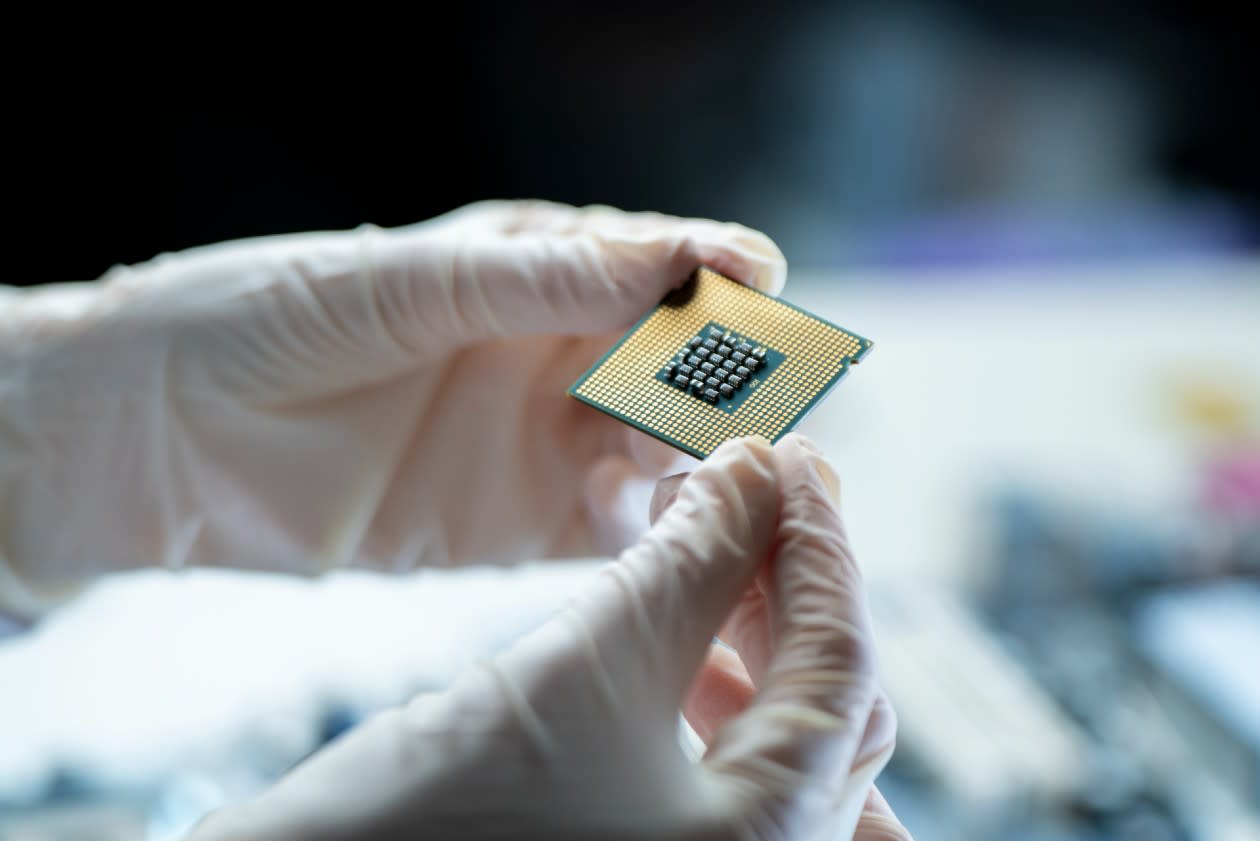Tech earnings season offered a fresh snapshot of how artificial intelligence (AI) continues to reshape the industry.
From cloud computing to advertising and infrastructure investment, the world’s biggest tech companies are leaning hard into AI – and investors are watching closely to see who’s leading, who’s lagging, and where the next wave of growth might come from.
At the same time, the sector has been under pressure.
New White House trade policies have created uncertainty around global supply chains and future demand, adding another layer of complexity to an already pivotal moment for the industry.
This article isn’t personal advice. If you’re not sure an investment is right for you, seek advice. Investments and any income from them will rise and fall in value, so you could get back less than you invest. Past performance isn’t a guide to the future and ratios also shouldn’t be looked at on their own.
Investing in an individual company isn’t right for everyone because if that company fails, you could lose your whole investment. If you cannot afford this, investing in a single company might not be right for you. You should make sure you understand the companies you’re investing in and their specific risks. You should also make sure any shares you own are part of a diversified portfolio.
Cloud Wars
Cloud growth was a bright spot from earnings across the three biggest names in the space.
Microsoft Azure led the charge, growing 33% thanks in large part to demand for AI tools powered by its OpenAI partnership and a growing customer base.
Google Cloud wasn't far behind with 28% growth, leaning on its strengths in generative AI and data platforms.
Amazon Web Services (AWS) still holds the biggest slice of the market at around 30%. But its slower 17% growth raised some eyebrows, as it lags in AI specific revenue streams compared to the other two.
It was important that we saw AI contribute to cloud growth and that was largely the case, we were also keen to find out whether supply had finally caught up to demand.
All three called out a lack of compute supply as holding back growth – that’s a positive tailwind for growth over the rest of the year as more supply comes online.
Tariff trouble
As far as direct impacts go, it’s the hardware giants Apple and Amazon that are the most impacted.
Broadly speaking there hasn’t been any major impact yet, but both companies spoke cautiously about the medium-term.
Apple went as far as to say that the second half of the year was difficult to map and that was one of the reasons the stock fell on the day.
Amazon’s e-commerce business is expected to slowdown in the coming quarter, but we think the guide of 5-9% growth still looks encouraging (quarter one – 9% growth).
There’s an argument that once the initial tariff hit has been absorbed, Amazon could see its competitive position improve as low-cost Chinese competition loses some of its edge.
On the digital side, we felt there was some concern heading into results that ad spend could come under pressure if there’s a general slowdown in economic activity. That’s not gone away, but bigger names like Meta and Alphabet look to be coping well.
Huge customer bases, a broad range of advertiser options, and improving ad targeting with AI are big enough tailwinds to drive impressive ad revenue growth, despite broader challenges.
The capex conundrum
There were some question marks around investment in new AI infrastructure, and whether it might slow as tariff’s muddy the outlook for demand.
However, the US giants continue to view this as pivotal area to invest, not to secure some growth in the coming year ahead, but to enable leadership over the next decade and beyond.
Of the big AI spenders, we saw Amazon, Alphabet and Microsoft keep their AI investment guidance unchanged.
Meta was the outlier, increasing the amount it expects to spend over the next year.
This was all a very good sign for the broader AI trade and for names like NVIDIA, whose chips, in our opinion, are likely to attract a large share of that capital.
The AI trade
Based on what we’ve seen from some of the biggest names in the tech world, the ongoing AI adoption, infrastructure buildout, and new ways of working are accelerating at pace.
We’re seeing cloud growth driven by new AI demand, ad revenue growing as AI tools improve ad targeting and monetisation, and no slowdown in investment.
We think the next innovation cycle, driven by AI, is happening now – and some of the biggest names on the planet are in great shape to capitalise.
There’s of course a lot of uncertainty in the air, and tech names tend to be more volatile than the broader market, so investors should prepare for ups and downs.
The author holds shares of NVIDIA.
This article is original Hargreaves Lansdown content, published by Hargreaves Lansdown. It was correct as at the date of publication, and our views may have changed since then. Unless otherwise stated estimates, including prospective yields, are a consensus of analyst forecasts provided by LSEG. These estimates are not a reliable indicator of future performance. Past performance is not a guide to the future. Investments rise and fall in value so investors could make a loss. Yields are variable and not guaranteed.
This article is not advice or a recommendation to buy, sell or hold any investment. No view is given on the present or future value or price of any investment, and investors should form their own view on any proposed investment. This article has not been prepared in accordance with legal requirements designed to promote the independence of investment research and is considered a marketing communication. Non-independent research is not subject to FCA rules prohibiting dealing ahead of research, however HL has put controls in place (including dealing restrictions, physical and information barriers) to manage potential conflicts of interest presented by such dealing. Please see our full non-independent research disclosure for more information.
Start investing by Direct Debit by 26 June 2025 in an HL Stocks and Shares ISA or Self-Invested Personal Pension (SIPP) and we’ll refund a year’s worth of account charges back in cash on your total monthly payments - letting you invest at no cost.
Your Direct Debit must stay in place for one year to qualify. Your cash refund will be paid by July 2026. See full offer terms. Other charges may apply.


